Sunday, September 8thWe left Paris on Fridays evenings and we arrived on Sunday morning at 4:00 am at Darwin. We haven't our bag in the arrival but QANTAS gives us a correct compensation, approximately 100 EURO a person and a shorts, a T-shirt and a toilet bag. Moreover, we have some clothes present with us in hand luggage. It is a chance because the recovery of luggage is going to turn out epic: it will be necessary 4 days to get back everything... After a breakfast taken in city, we discover our first birds to the sunrise. We join the Esplanade which follows the coast under the shape of a small woody cliff. Many novelties everywhere! In particular, we make of very beautiful observations of Figbird and Yellow Oriole. These two species will be much wilder everywhere else. We need quite a lot of time to get through all these new species for us: Orange-footed Scrubfowl, Straw-necked Ibis, White-breasted Woodswallow, Pied Imperial-Pigeon... We get back our 4WD in the middle of morning, and we take the direction of "East Point Recreation Reserve", few kilometers North of Darwin. We see our first kangarooes, our first Red-tailed Black-Cockatoo (among the biggest parrots of Australia) and a small band of Rainbow Lorikeet: common but one of the most beautiful Lorikeet of Australia... It is very warm and during a short pose after the lunch I have the luck to see an adult Brahminy Kite in flight. After a small visit of Darwin, we drive to our guest house: Eden at Fogg Dam; a farm unless 3 kilometres of one of the most interesting ornithological sites in the region of Darwin: Fogg Dam. It is a big swampy zone surrounded with forest and meadows. Our hosts are really charming: knowing that it was our honeymoon, they offered us a bottle of Yellow wine, an Australian champagne. Monday, September 9thIn the early hours we begin a walk on the dike which separates the swamp in two. This dike, about 2 kilometres, was built in the 50s during an attempt to grow a plantation of rice. Fortunately, this activity was not very profitable except for birds! For once they take advantage of a human organization... The day begin quietly with species already seen as Torresian Crow, groups of magpies Gooses in flight and one of the most common birds of the continent: the Magpie-lark. After a few minutes, we see some new species like Clamorous Reed-Warbler, Golden-headed Cisticola, some Brolgas and some birds of prey such as Whistling Kite and a Goshawk (probably a brown one...). The areas of permanent water are very rich: Australian Darter, Green Pygmy-goose, Comb-crested Jacana, Little Pied Cormorant and even crocodile but we didn't see them. In the tick vegetation of the bank we catch a glimpse of a White-browed Crake that I can photograph. Rainbow Bee-eater are present as well as many passerines in the copses of trees along the road: Restless Flycatcher, Crimson Finch, some Honeyeaters, Mistletoebird. In Australia you find everywhere parakeets and Cockatoo, and it is really magnificent to see them; on the other hand when you hear them, it is not generally very harmonious! At the end of the dike we found some agile Kangarooes of which a mother with a baby. It caught us 7 hours for less than 4 kilometers: a good rhythm for ornithologists! After a well deserved meal, we took advantage of the swimming pool under a temperature of 35°C in the shadow. Then, we made a walk in the woodiest part of Fogg Dam that allow us to complete our observations on this site. Tuesday, September 10thWe left relatively early in the morning Eden at Fogg Dam for a boat's cruise during 3 hours on the Mary River. On the 20 kilometers of track to the river, we saw some Kangarooes (always agile one) and especially an observation of a half-dozen of Little Cockatoo really not wild. We arrived at about 9:30 am to rent a sort of raft equipped with a small engine of 10 horses. It is widely sufficient and the size of the boat allow me to make all the pictures wanted: in particular White-bellied Sea-Eagle who are rather numerous everywhere on the river, but also Black-necked Stork, Plumed Whistling-Duck, Nankeen Night-Heron and several species of Cormorants. Salties are widely visible at this time... Compared with the Kakadu's Yellow Water Cruise which is well known, we are free to observe all the fauna and this freedom is really pleasant. Moreover, the rent of half-day costs cheaper than the cruise of Kakadu which lasts only 2 hours. So, I recommend this stroll particulary if you want to make pictures... We lunched near a small pond few kilometres away. The concentration of birds was really impressive; in France, such a hole of water would gave a couple of Coot or Moorhen only! The presence of some eucalyptus Trees offered us a little of shadow very appreciated: it maked 36°C. At the top of trees, hundred of Varied Lorikeet fed noisily. Nevertheless they weren't really easy to see! We left this charming place (but very warm!) for driving up to the lake of Mamukala in the heart of the National Park of Kakadu. The density of birds was even more impressive here. From the look-out post where we were, several species are unless 100 metres. That allowed me to complete our picture's album: Pied Heron, Wandering Whistling-Duck, Radjah Shelduck, Australian Pratincole, Australian Pelican... Far off, our telescopes allowed us to see 2 Dingoes which take charge with cleaning a boar's carcass. At sunset, we settle down to the campsite of Cooinda for three nights. Wednesday, September 11thWe boarded at 6:30 am for the Yellow Water Cruise. This time, the boat was rather big and could contain more than 50 passengers. It was rather touristy but frankly it was a very nice cruise. The landscapes was magnificent and we saw lot of birds quite as salties. Among the most remarkable sights: the Little Kingfisher a rare bird in all Australia and a sort of snake which seemed rather uncommon... After the cruise, we decided to walk to the camp through the forest with the hope to arrive at a correct time to have lunch. We missed it: we arrived at about 2:30 pm but there were compensations: Brush Cuckoo, Red-winged Parrot, Leaden Flycatcher, Double-barred Finch, etc... The afternoon was quiet: it was necessary for us to rest of the jet lag and the increase of the temperature. We visited "Bowali Visitor Centre" and we went to get back our bags, at least a part ! Thursday, September 12thWith a couple of Dutch whom we met accidentally for the third time, we began the visit of Nourlangie Rock. This cultural Mecca of Kakadu was also interesting for birds. Here, the biotope was slightly different because we were along an abrupt cliff which surrounded the Park. The most interesting birds was essentially passerines, in particular 3 Black-tailed Treecreeper and few Red-backed Fairywren of which a magnificent male in bridal plumage. After a fast lunch we began a track of more than 60 kilometers between the Kakadu Holiday Village and the old track "Old Jim Jim Road". It was a little bit too long but some sites was wonderfull, like "Red Lilly Billabong" and "Alligator Billabong". Once again the time missed us and we ended at night not without having seen some Nightjars and probably a Australian Owlet-Nightjar which almost passed under wheels even if I drove less than 20 kph! Friday, September 13thJust before leaving Kakadu, I finally identified a bird tracked down the previous days around the campsite but without being able to give it a name. It was a big and chestnuts passerine: the Great Bowerbird which belongs one of the most typical families of Australian birds ! As what, we never prepare well enough its trip... We began today the road to Alice Spring. However we spent the morning in the South West of Kakadu to "Gunlom Waterfall Creek". It was a 70 meters waterfall very impressive during the rainy season but a simple net of water in September. We were in search of some endemic Pigeon but actually we did not see it. On the other hand the lookout was very nice on the top of the cliff. However the end of the park was very interesting for pigeons and parakeets: we saw a group of Cockatiels and Red-winged Parrots and Galahs together with some Partridge Pigeon. When we joined the main road between Darwin and Alice Spring, there was 1300 kilometers to drive in. Furthermore, we had to arrive before night. Indeed, the number of Kangarooes crushed along the road by "Road Trains" showed us that driving at night hadto be very dangerous. It was rather sad, as far as the alive Kangarooes are uncommon during the day! A small consolation, the carcasses attracted some birds of which the Wedge-tailed Eagle. A stage was imperative. Villages where we could spend the night was approximately spread out all 100 kilometers. We stop finally to Elliot in the motel of the city. We lunch in the adjacent restoring bar. The main customers was the aborigines: without comment... For night, we prefered to sleep on our sleeping bags rather than on sheets... |
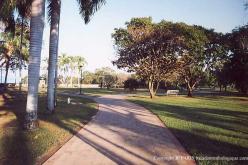 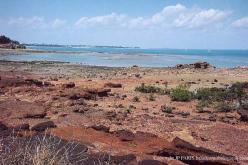 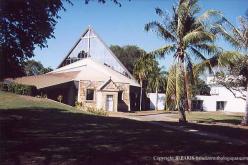 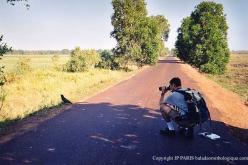 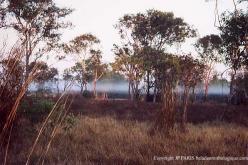 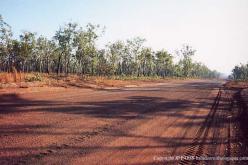 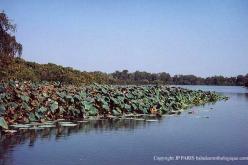 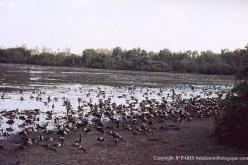 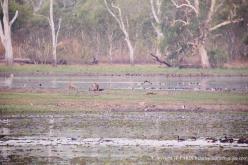 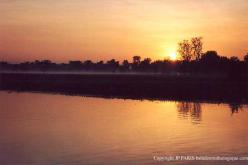 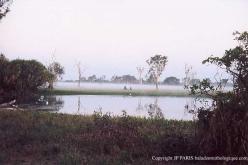 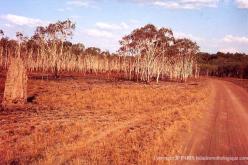 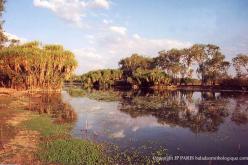 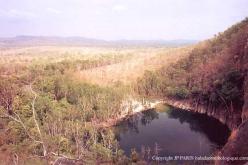 |